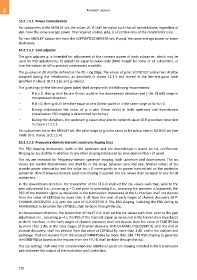Page 780 - 5G Basics - Core Network Aspects
P. 780
2 Transport aspects
10.2.1.5.1 Power normalization
For subcarriers in the MEDLEY set, the values (X, Y) shall be scaled such that all constellations, regardless of
size, have the same average power. The required scaling, χ(bi), is a function only of the constellation size.
For non-MEDLEY subcarriers from the SUPPORTEDCARRIERS set, if used, the same average power or lower
shall apply.
10.2.1.5.2 Gain adjuster
The gain adjuster gi is intended for adjustment of the transmit power of each subcarrier, which may be
used for PSD adjustments, to adjust the signal-to-noise ratio (SNR) margin for some or all subcarriers, or
turn the subcarrier off to prevent unnecessary crosstalk.
The gi values in dB shall be defined as the 20 log10(gi). The values of gi for all MEDLEY subcarriers shall be
assigned during the initialization, as described in clause 12.3.3 and stored in the bits-and-gains table
specified in clause 10.2.1.2 (bi and gi values).
The gi settings (in the bits-and-gains table) shall comply with the following requirements:
– If bi > 0, then gi shall be one (linear scale) in the downstream direction and [−30, 0] (dB) range in
the upstream direction.
– If bi = 0, then gi shall be either equal to zero (linear scale) or in the same range as for bi > 0.
– During initialization the value of gi is one (linear scale) in both upstream and downstream
(initialization PSD shaping is determined by the tssi).
– During the showtime, the upstream gi values may also be updated via an OLR procedure described
in clause 11.2.2.5.
For subcarriers not in the MEDLEY set, the valid range of gi is the same as for subcarriers in MEDLEY set (see
Table 10-5, clause 10.2.1.5.4).
10.2.1.5.3 Frequency-domain transmit spectrum shaping (tssi)
The PSD shaping mechanism, both in the upstream and the downstream is based on tssi coefficients.
Shaping by tssi shall be in addition to any other shaping introduced by time-domain filters (if used).
The tssi are intended for frequency-domain spectrum shaping, both upstream and downstream. The tssi
values are vendor discretionary and shall be in the range between zero and one. Smaller values of tssi
provide power attenuation and the value tssi = 0 corresponds to no power transmitted on the particular
subcarrier. If no frequency-domain spectrum shaping is applied, the tssi values shall be equal to one for all
subcarriers.
In the downstream direction, the transmitter of the FTU-O shall set the tssi values such that, prior to the
gain adjustment (i.e., assuming gi =1) and prior to precoding (i.e., assuming the precoder is bypassed), the
PSD of the transmit signal as measured in the termination impedance at the U interface shall not deviate
from the value of CDPSDds by more than 1 dB from the start of early stages of channel discovery (O-P-
CHANNEL-DISCOVERY 1-1) until the start of O-P-VECTOR 2. The PSD shaping, including the PSD ceiling by
MAXMASKds to generate the V2PSDds, shall be done through the tssi.
In the upstream direction, the transmitter of the FTU-R, shall set the tssi values such that, prior to the gain
adjustment (i.e., assuming gi =1), the PSD of the transmit signal as measured in the termination impedance
at the U interface, in the early stages of channel discovery shall not deviate from the value of STARTPSDus
by more than 1 dB; in the later stages of channel discovery (R-P-CHANNEL DISCOVERY 2) until the end of
channel discovery, shall not deviate from the value of CDPSDus by more than 1 dB; and in the analysis and
exchange, shall not deviate from the value of MREFPSDus by more than 1dB. The PSD shaping to generate
the MREFPSDus based on the request from the FTU-O shall be done through the tssi.
The tssi settings shall take into consideration any additional spectrum shaping included in the transmission
path between the output of the modulator and U interface.
770

